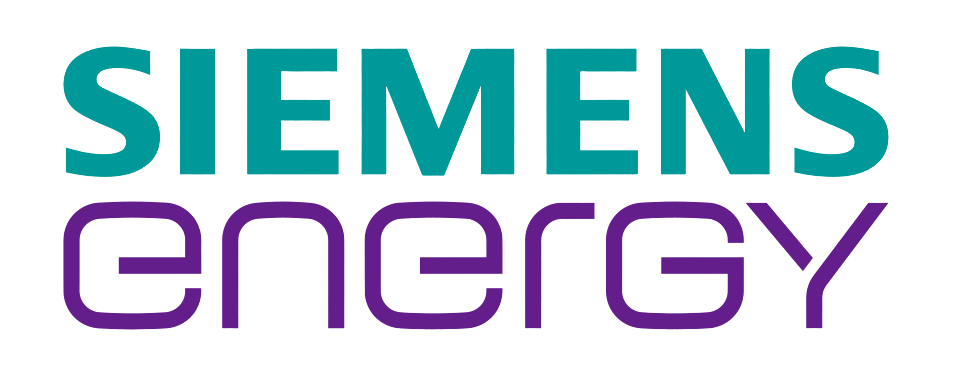Future Outlook – Alternative Grid-scale Energy Storage Technologies
 Energy
Energy
Introduction
As the penetration of renewable energy into the grid is increasing, energy storage is becoming an important link to the energy system. Energy storage can act as a standby power supply, can be deployed to compensate for the intermittency of renewable power generation, can provide ancillary grid services, and has the potential to differ transmission and distribution infrastructure investments.
Lithium-ion technology is the most widely deployed technology for energy storage purposes. The technology has proven its effectiveness from large scale grid applications to home batteries. Although li-ion technology has captured the majority market share, utilities and independent power producers (IPPs) are exploring alternative storage technologies. Though the cost of Li-ion batteries is declining day by day, there are certain limitations associated with these batteries. Safety issues and the use of cobalt in the batteries are leading to a push for alternative storage technologies. Further, li-ion batteries experience degradation over life and this can have an impact on battery performance.
Alternative technologies and future outlook
Considering the demand for alternative storage technologies, many market players are coming up with new technologies to compete with li-ion batteries. Cryogenic energy storage, gravity energy storage, and flow batteries have captured market attention on account of the successful deployment of projects based on these technologies. Key drivers and challenges associated with these technologies are described in the following sub-section.
Cryogenic energy storage
Cryogenic energy storage technology makes use of low-temperature liquids such as liquid air or liquid nitrogen as energy storage. The energy storage technology can be deployed for large scale and long-duration applications. The cryogenic energy storage system can be built at low costs and have 30+ years of lifetime. It can be built anywhere and marks zero emissions. The system demonstrates an efficiency of 60-70%.
Highview Power is the key player to supply cryogenic energy storage systems. An important driver for the deployment of this technology is the need for long-duration energy storage. Cryogenic energy storage has very steep economics of scale and is very cost-effective for larger size storage systems. The technology has the lowest cost of storage among competitors when deployed for large size (say above 25MW) and long duration (above 4 hours) of storage. Increasing the system size requires increasing the number of tanks, which are made up of steel and have less cost associated with it. Further, the supply chain for manufacturing the system is very well established. The technology uses no rare materials and there is no potential for leaks and thermal runways.
Since the technology achieves economy of scales at higher storage capacity, it is not suitable for small scale applications. Further, the size of the system is comparatively larger than li-ion batteries and this poses a constraint on the deployment of the cryogenic storage system. The technology is expected to capture a big market share in large scale storage deployments.
Key highlights of cryogenic energy storage technology are depicted in the following exhibit. The parameters are compared with li-ion technology.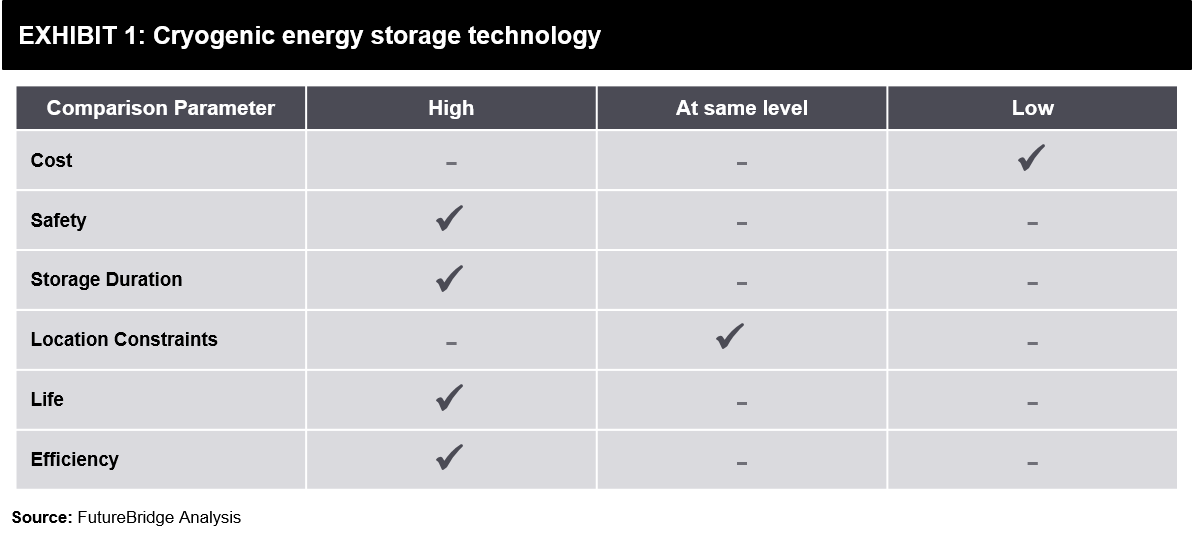
Gravity storage
The gravity storage concept is based on the idea of using excess electricity to lift the weight, so the energy can be recovered when needed by letting the weight drop down again. The technology uses the same principle as pumped hydro energy storage but needs no specific topography and is more cost-effective. Gravity storage has low initial and operating costs. The technology requires minimal and comparatively cheaper raw material and can serve for a longer duration of life. The benefits also include very fast response times and hence eligibility for short and medium-term ancillary services. The system demonstrates efficiency as high as 80-90 percent.
Energy Vault is the leading market player in gravity storage space. The company claims that its system is around 50% cheaper than li-ion battery storage technology. The use of cheaper concrete as raw material makes the system drastically cheap as compared to costly batteries. Along with the low costs, higher efficiency and very short ramp rates are the key drivers of gravity storage technology.
Like cryogenic energy storage technology, gravity storage is also most suitable for large scale and long-duration applications and requires more space to accommodate. The main threat associated with this technology is the potential entry of new low-cost technologies or rapid cost reductions in competing technologies throughout the long technical life of gravity energy storage. The technology needs to prove its cost-effectiveness in future deployments also to sustain in the market and to attract investments.
Key highlights of gravity energy storage technology are depicted in the following exhibit. The parameters are compared with li-ion technology.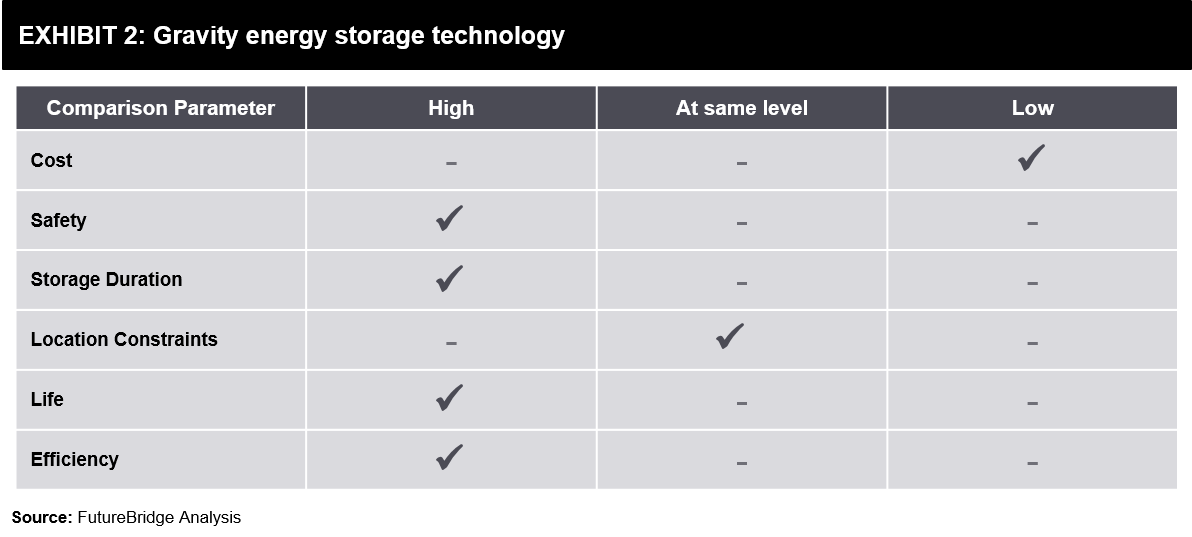
Flow battery
Flow batteries are comparatively older and gaining acceleration again on the background of safety issues around li-ion batteries. Safe operation, long life with no degradation, and decoupling between power and energy are the key drivers of flow battery technology.
Despite its advantages over li-ion batteries, these batteries are not competitive on the cost front at this stage. Electrolytes (E.g. Vanadium) used in flow batteries are costly and add significantly to the system cost. To solve the problem of higher upfront cost, many flow battery manufacturers have started offering vanadium lease/ buyback programs. Though commercialized by many companies, flow batteries are not yet competitive with li-ion batteries on cost and scale of deployment parameters. It is important to see how the flow battery technologies evolve and how the costs of raw materials used in the batteries decline overtime to decide the success of flow batteries.
Key highlights of flow battery technology are depicted in the following exhibit. The parameters are compared with those of li-ion technology.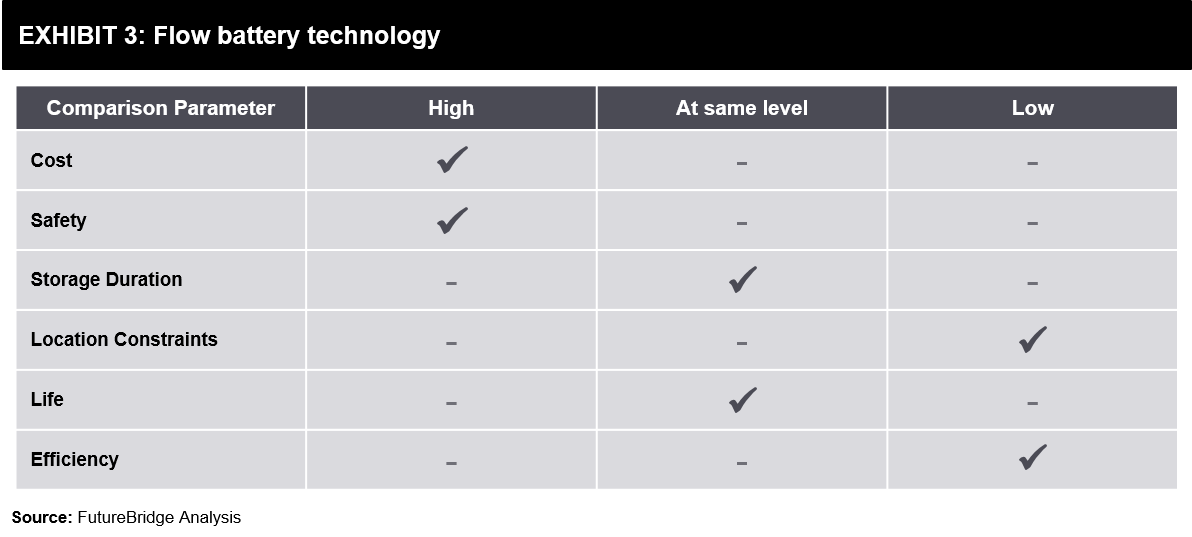
Going forward
Although the current energy storage market is dominated by lithium-ion batteries, the industry developments clearly show an increasing focus on alternative energy storage technologies. Heavy investments being fetched by these technologies are a clear indication of the potential of these technologies to unseat li-ion battery as the market leader. Cost reductions, safety, efficiency improvements, and ability to scale will be deciding factors for the success of alternative energy storage technologies.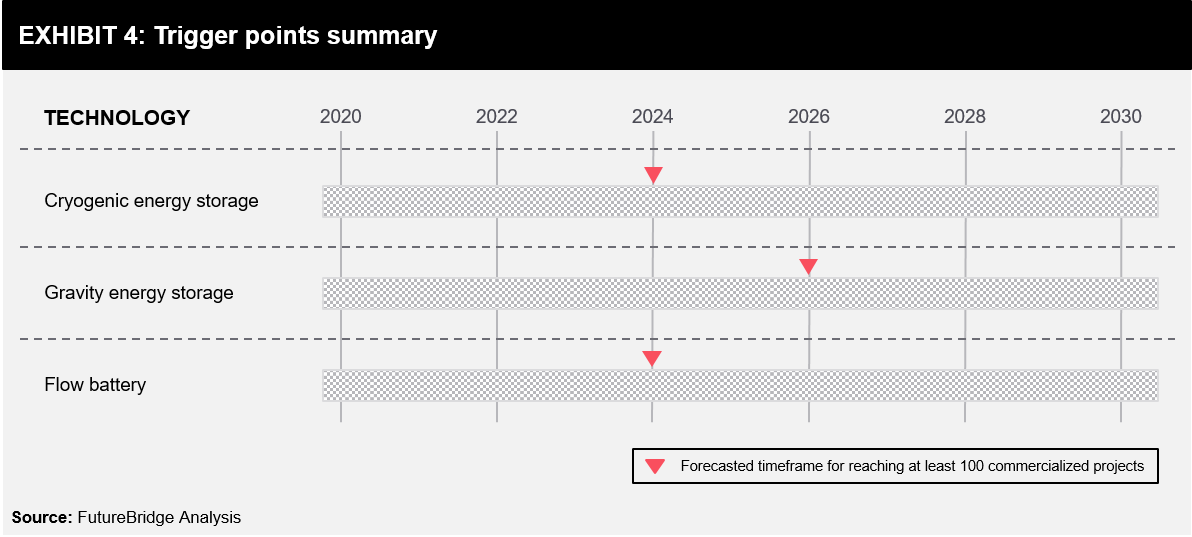
The alternative technologies with the potential to grab a substantial market share are yet to reach the full commercialization level. Cryogenic technology has already started witnessing commercial deployments and is expected to reach the full commercialization level soon. Whereas gravity energy storage is in the early demonstration phase and will take time to get fully commercialized. Higher costs and lower efficiencies are holding back the deployment of flow batteries and more time will be required to bring the technology to cost comparison.



 6 min read
6 min read



























